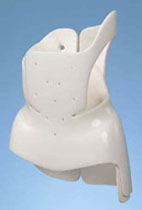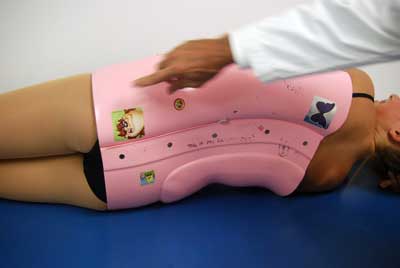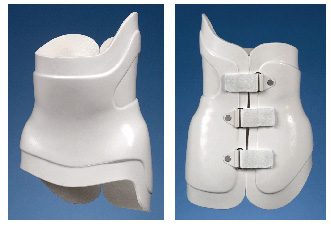Scoliosis
Scoliosis Scoliosis is a lateral (toward the side) curvature in the normally straight vertical line of the spine. The normal spine curves gently backward in the upper back and gently inward in the lower back.
Scoliosis is a lateral (toward the side) curvature in the normally straight vertical line of the spine. The normal spine curves gently backward in the upper back and gently inward in the lower back.
When viewed from the side, the spine should show a mild roundness in the upper back and shows a degree of swayback (inward curvature) in the lower back.
When a person with a normal spine is viewed from the front or back, the spine appears to be straight.
When a person with scoliosis is viewed from the front or back, the spine appears to be curved.
What Causes Scoliosis?
There are many types and causes of scoliosis, including:
Congenital scoliosis. A result of a bone abnormality present at birth.
Neuromuscular scoliosis. A result of abnormal muscles or nerves, frequently seen in people with spina bifida or cerebral palsy or in those with various conditions that are accompanied by, or result in, paralysis.
Degenerative scoliosis. This may result from traumatic (from an injury or illness) bone collapse, previous major back surgery or osteoporosis (thining of the bones).
Idiopathic scoliosis. The most common type of scoliosis, idiopathic scoliosis, has no specific identifiable cause. There are many theories, but none have been found to be conclusive. There is, however, strong evidence that idiopathic scoliosis is inherited.
Who Gets Scoliosis?
Approximately 2% to 3% of Americans at age 16 has scoliosis. Less than 0.1% has curves measuring greater than 40 degrees, which is the point at which surgery becomes a consideration. Overall, girls are more likely to be affected than boys. Idiopathic scoliosis is most commonly a condition of adolescence affecting those ages 10 through 16. Idiopathic scoliosis may progress during the "growth spurt" years, but usually will not progress to adulthood.
How Is Scoliosis Diagnosed?
Most curves are initially detected on school screening exams, by a child's pediatrician or family doctor, or by a parent. Some clues that a child may have scoliosis include uneven shoulders, a prominent shoulder blade, uneven waist or leaning to one side. The diagnosis of scoliosis and the determination of the type of scoliosis are then made by a careful bone exam and an X-ray to evaluate the magnitude of the curve.
What Is the Treatment for Scoliosis?
The majority of adolescents with significant scoliosis with no known cause are observed at regular intervals (usually every four to six months), including a physical exam and a low radiation X-ray. Treatments include:
Braces. Bracing is the usual treatment choice for adolescents who have a spinal curve between 25 to 40 degrees -- particularly if their bones are still maturing and if they have at least two years of growth remaining.
The purpose of bracing is to halt progression of the curve. It may provide a temporary correction, but usually the curve will assume its original magnitude when bracing is eliminated.
Boston TLSO  The Boston Scoliosis Brace is accepted worldwide as the proven system for the non-operative treatment of idiopathic scoliosis.
The Boston Scoliosis Brace is accepted worldwide as the proven system for the non-operative treatment of idiopathic scoliosis.
The Boston Scoliosis Brace is currently used as the primary orthotic solution at some of the worlds foremost pediatric medical centers.
Providence Scoliosis system
Spinal Indications - Lumbar curves
- Lumbar curves
- Thoracic curves
- Double major curves
- Thorocolumbar curves
Features
By combining precise grid coordinates of the patented measuring board, (picture inset), and utilization of a CAD CAM system we can effectively establish consistent modification strategies. The Providence Scoliosis system aggressively corrects the curves while the patient sleeps.
Charleston Bending Brace TLSO The Charleston Bending Brace is a nocturnal TLSO for scoliosis it is effective for the noncompliant Boston brace wearer or as an adjunct to the Boston Brace.
The Charleston Bending Brace is a nocturnal TLSO for scoliosis it is effective for the noncompliant Boston brace wearer or as an adjunct to the Boston Brace.
The Charleston Bending brace overcorrects the curve while sleeping, This TLSO may not be worn when up because of the unbalanced position that it puts you in.
Soft Neuromuscular Scoliosis TLSO
 Indications:
Indications:
Cerebral palsy, Osteoporosis, Myelomeningocele, Wheelchair seating support, Scoliotic deformities
- Muscular dystrophy, Cancer patients, Geriatrics
Features
Designed for patients that cannot tolerate a rigid orthosis. The Flex Foam offers a softer inner layer of foam for the relief of bony prominences combined with a dense outer foam. The rigid external frame provides support where indicated. The frame is detachable and can be strategically adjusted as indicated by patient needs.

